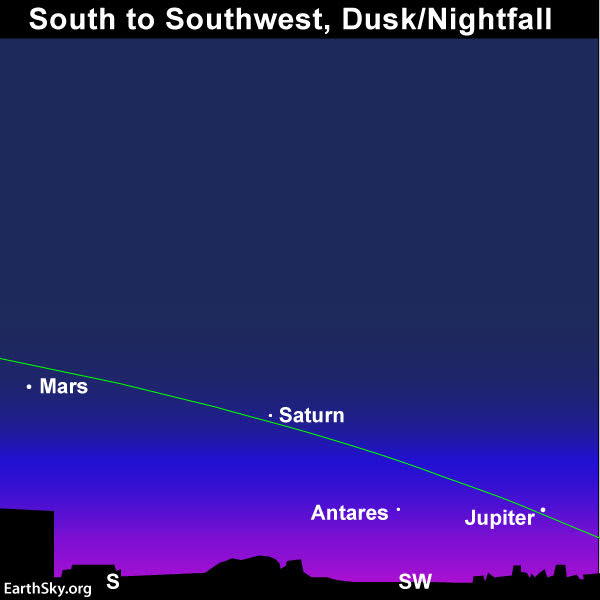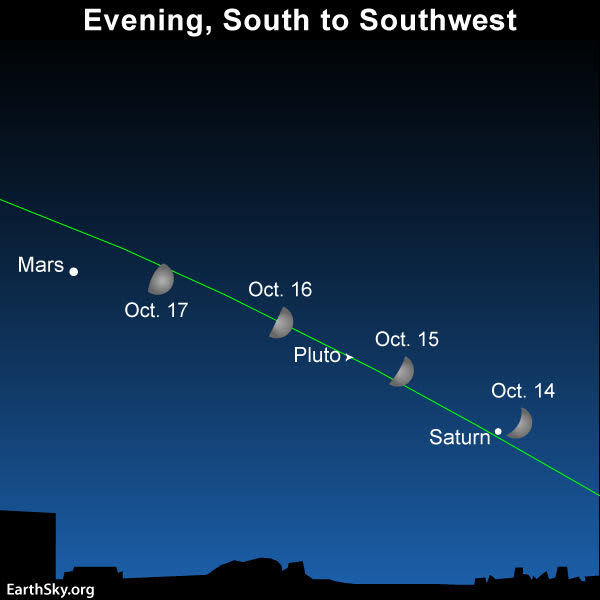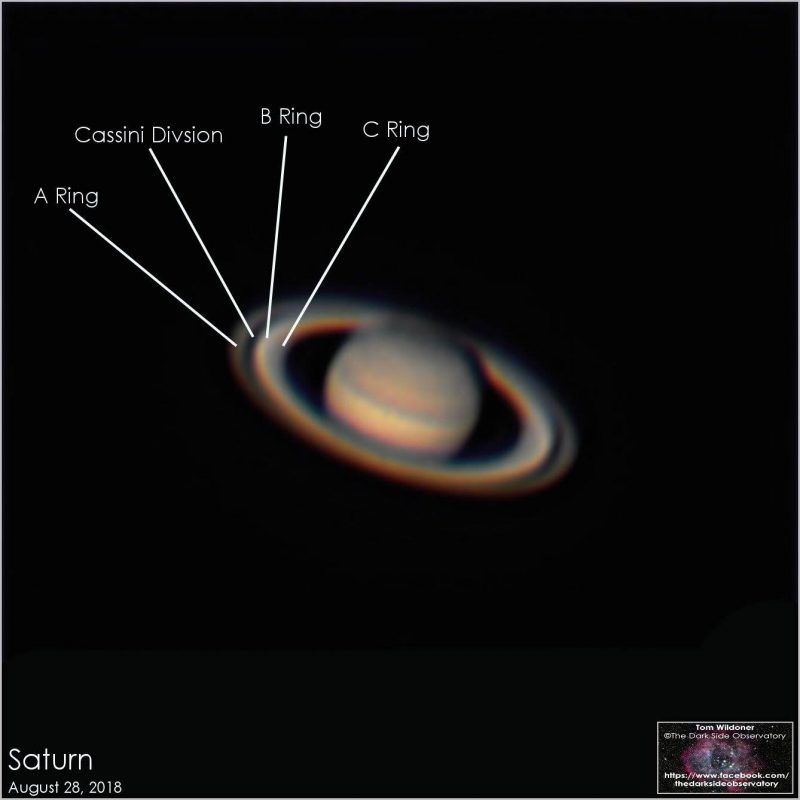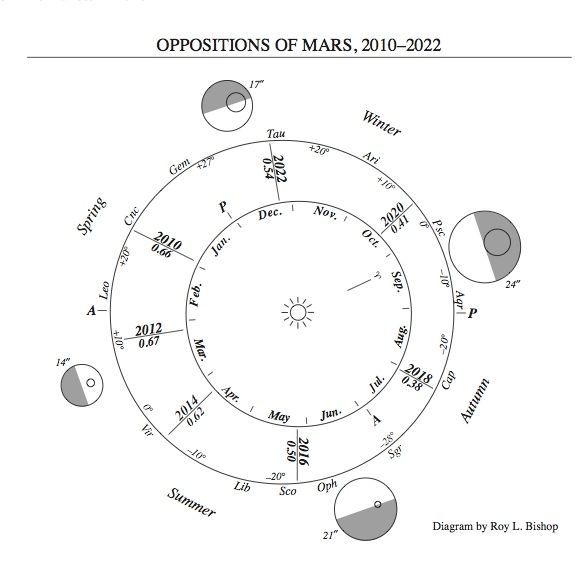

In October 2018, at dusk and/or nightfall, watch for Mars to appear in the southern sky, Jupiter in the southwest, and Saturn roughly midway between.
Three evening planets are in good view as darkness falls in the first half of October 2018: Mars, Saturn and Jupiter. From mid-northern latitudes, you may have to struggle to catch Venus, the sky’s brightest planet, as it sits low in the sky, and below Jupiter, at evening dusk. Southerly latitudes may spot Mercury as an evening “star” as the month draws to a close. Click the name of a planet to learn more about its visibility in October 2018: Venus, Jupiter, Saturn, Mars and Mercury

It’ll be much easier to spot Venus, the sky’s brightest planet, from the Southern Hemisphere.
Venus, the brightest planet, ranks as the 3rd-brightest celestial object after the sun and moon. Nonetheless, this world will be difficult to spot from mid-northern latitudes, yet rather easy to see from the Southern Hemisphere. This world will sink closer to the setting sun day by day, and will move into the morning sky by the month’s end.
We give you fair warning. It’ll be much easier to spot the young waxing crescent moon in the vicinity of Venus after sunset October 10 and 11 from the northern tropics and Southern Hemisphere than at mid-northern latitudes. That’s why the above sky chart represents a Southern Hemisphere perspective. Click here for a sky chart showcasing a mid-northern view (United States, mainland Europe, Japan).
At mid-northern latitudes, Venus sets roughly one hour after sunset in early September. By mid-month, Venus will set with the sun.
At temperate latitudes in the Southern Hemisphere, Venus sets about 2 1/2 hours after the sun in early October and then sets with the sun in late October. Because Venus passes over 6 degrees south of the sun at its inferior conjunction on October 26, 2018, it might be possible for middle and far southern latitudes in the Southern Hemisphere to see Venus as both an evening and morning “star” for a day or two around inferior conjunction.
Why the stark difference in Venus’ visibility from the Northern and Southern Hemispheres? It’s because of the angle of the ecliptic, which marks the annual path of the sun, and the approximate path of the moon and planets across our sky. From our northerly latitudes, the ecliptic falls close to the horizon and makes a shallow angle with the horizon as the sun sets in early autumn. That keeps Venus low, and buried deep in evening twilight, at mid-northern latitudes.

Venus, the moon – and see the moon’s reflection in Lisbon, Portugal on August 13, 2018. Photo by Henrique Feliciano Silva,
The Southern Hemisphere has the big advantage in seeing Venus because October is an early spring month in that part of the world. Therefore, the ecliptic crosses their sky way up high and intersects the horizon nearly straight up and down. That places Venus above the setting sun (rather than to the side of it as for us northerners). At temperate latitudes in the Southern Hemisphere (South Africa, southern Australia, New Zealand), Venus sets about 2 1/2 hours after the sun in early October (as opposed to about one hour after sunset a mid-northern latitudes).
In short, when it comes to the height of the ecliptic in the evening sky, remember the saying “spring up and fall down.” At sunset on the spring equinox, the ecliptic soars highest up for the year. At sunset on the autumn equinox, the ecliptic falls lowest down. That applies to both the Northern and Southern Hemispheres.
From the Southern Hemisphere, look for Venus to adorn the evening sky from now till nearly the end of October 2018.

Look for the moon to be in the neighborhood of Jupiter for several evenings, centered on or near October 11, 2018. Read more.
Jupiter remains in the evening sky all through October 2018. Around the world, you’ll find Jupiter highest up around dusk or nightfall. Jupiter appears rather low in the southwest sky at northerly latitudes; in the Southern Hemisphere, you’ll see Jupiter fairly high in the western sky. Day by day, Jupiter falls closer to the setting sun, and sets sooner after sundown. By November 2018, Jupiter will exit he evening to sky and pass over into the morning sky.
Once again, as with Venus, Jupiter stays out longer after sunset in the Southern Hemisphere. That’s because the ecliptic (pathway of the sun, moon and planets) hits the evening horizon almost straight up and down in the Southern Hemisphere, yet at a shallow angle in the Northern Hemisphere.
For instance, at mid-northern latitudes (United States, mainland Europe, Japan), Jupiter sets about two hours after the sun in early October and one hour after at the month’s end.
In contrast, at temperate latitudes in the Southern Hemisphere (Cape Town, South Africa, and southern Australia), Jupiter sets about 3 1/2 hours after the sun in early October and about 1 1/2 hours after by the month’s end.
Jupiter is brighter than any star, but it’s not brighter than Venus, which lurks below Jupiter at dusk. Last month, in September 2018, Jupiter reclaimed its spot as the 4th-brightest celestial object, after the sun, moon and Venus. For some two months, Mars supplanted Jupiter as the brighter of these two heavenly bodies from about July 7 to September 7.
Let the moon guide your eye to Jupiter for several evenings, centered on or around October 11. (See the above sky chart.)

Watch for the moon to pair up with Saturn on October 14, 2018, and then to meet up with Mars on October 17. Read more.
Use Mars to find Saturn in October 2018. Although Mars fades this month, the red planet remains bright and beautiful, shining more brilliantly than a 1st-magnitude star throughout October 2018. Around the world in October, Mars transits – reaches its highest point in the sky – around dusk or nightfall. Once you see Mars, look for Saturn in between Mars and Jupiter, as shown on the sky chart below.
Click here for a recommended sky almanac providing you with the transit times for Mars.

In October 2018, at dusk and/or nightfall, watch for Mars to appear in the southern sky, Jupiter in the southwest, and Saturn roughly midway between.
From the Southern Hemisphere, Mars shines quite high up in the sky at dusk/nightfall whereas Saturn and Jupiter line up almost vertically beneath Mars.
From mid-northern latitudes, Saturn stays out until around 9 p.m. (10 p.m. daylight saving time) in early October. By the month’s end, Saturn will set around 8 p.m. (9 p.m. daylight saving time). Mars will follow Saturn beneath the western horizon several hours after Saturn does.
From temperate latitudes in the Southern Hemisphere, Saturn sets after midnight in early October and around 11 p.m. in late October. Mars stays out until well after midnight all month long.
You can tell Mars from Saturn because Mars has a reddish color and Saturn looks golden. Binoculars show their colors better than the eye alone.
Watch for the moon to pair up with Saturn on or near October 14 and with Mars on October 17 and 18.

View larger. | Photo by Tom Wildoner at the Dark Side Observatory, Weatherly, Pennsylvania, August 28, 2018. Sky-Watcher Esprit 120mmED Triplet Refractor, Celestron CGEM-DX mount, ASI 290MC, and Televue 2.5x Powermate (1.25”). Captured with SharpCap software (best 25 percent of 30k frames) and processed in Corel Paintshop Pro. Thank you, Tom!
Both Mars and Saturn are slowly dimming throughout the month. Because Mars is dimming at a faster rate than Saturn is, Mars appears nearly 5 times brighter than Saturn at the beginning of the month, but less than 3 times brighter by the month’s end.
Remember Mars’ historically close opposition of August 28, 2003? That year, it was closer and brighter than it had been in some 60,000 years. The July 2018 opposition was the best since 2003.
Click here for more about close and far Mars oppositions

Diagram by Roy L. Bishop. Copyright Royal Astronomical Society of Canada. Used with permission. Visit the RASC estore to purchase the Observer’s Handbook, a necessary tool for all skywatchers. Read more about this image.
Mercury, the innermost planet of the solar system, is an evening planet (at least nominally) all month long in October 2018. However, the Southern Hemisphere has the big advantage over the Northern Hemisphere for spotting Mercury this month. The Southern Hemisphere and the northern tropics have the opportunity to spot the rather loose Mercury-Venus conjunction in mid-October 2018, as shown on the sky chart below. After that, southerly latitudes can also watch for the tighter Mercury-Jupiter conjunction in late October 2018.

In the Southern Hemisphere, and possibly the northern tropics, you have a decent chance of spotting the planets Mercury and Venus at evening dusk. The same can’t be said for Mercury and Venus at northerly latitudes, but Jupiter is still a possibility. Click here to find out when the sun, Mercury and Venus set in your sky.
What do we mean by bright planet? By bright planet, we mean any solar system planet that is easily visible without an optical aid and that has been watched by our ancestors since time immemorial. In their outward order from the sun, the five bright planets are Mercury, Venus, Mars, Jupiter and Saturn. These planets actually do appear bright in our sky. They are typically as bright as – or brighter than – the brightest stars. Plus, these relatively nearby worlds tend to shine with a steadier light than the distant, twinkling stars. You can spot them, and come to know them as faithful friends, if you try.
Bottom line: In October 2018, four planets arc across the sky at dusk and nightfall. Venus lights up the western sky, with Jupiter shining above Venus. Mars and Saturn light up the southern sky at nightfall from northerly latitudes. From the Southern Hemisphere, Mars and Saturn shine high overhead. Click here for recommended almanacs; they can help you know when the planets rise, transit and set in your sky.
Don’t miss anything. Subscribe to EarthSky News by email
Visit EarthSky’s Best Places to Stargaze, and recommend a place we can all enjoy.
Help EarthSky keep going! Donate now.
from EarthSky https://ift.tt/IJfHCr


In October 2018, at dusk and/or nightfall, watch for Mars to appear in the southern sky, Jupiter in the southwest, and Saturn roughly midway between.
Three evening planets are in good view as darkness falls in the first half of October 2018: Mars, Saturn and Jupiter. From mid-northern latitudes, you may have to struggle to catch Venus, the sky’s brightest planet, as it sits low in the sky, and below Jupiter, at evening dusk. Southerly latitudes may spot Mercury as an evening “star” as the month draws to a close. Click the name of a planet to learn more about its visibility in October 2018: Venus, Jupiter, Saturn, Mars and Mercury

It’ll be much easier to spot Venus, the sky’s brightest planet, from the Southern Hemisphere.
Venus, the brightest planet, ranks as the 3rd-brightest celestial object after the sun and moon. Nonetheless, this world will be difficult to spot from mid-northern latitudes, yet rather easy to see from the Southern Hemisphere. This world will sink closer to the setting sun day by day, and will move into the morning sky by the month’s end.
We give you fair warning. It’ll be much easier to spot the young waxing crescent moon in the vicinity of Venus after sunset October 10 and 11 from the northern tropics and Southern Hemisphere than at mid-northern latitudes. That’s why the above sky chart represents a Southern Hemisphere perspective. Click here for a sky chart showcasing a mid-northern view (United States, mainland Europe, Japan).
At mid-northern latitudes, Venus sets roughly one hour after sunset in early September. By mid-month, Venus will set with the sun.
At temperate latitudes in the Southern Hemisphere, Venus sets about 2 1/2 hours after the sun in early October and then sets with the sun in late October. Because Venus passes over 6 degrees south of the sun at its inferior conjunction on October 26, 2018, it might be possible for middle and far southern latitudes in the Southern Hemisphere to see Venus as both an evening and morning “star” for a day or two around inferior conjunction.
Why the stark difference in Venus’ visibility from the Northern and Southern Hemispheres? It’s because of the angle of the ecliptic, which marks the annual path of the sun, and the approximate path of the moon and planets across our sky. From our northerly latitudes, the ecliptic falls close to the horizon and makes a shallow angle with the horizon as the sun sets in early autumn. That keeps Venus low, and buried deep in evening twilight, at mid-northern latitudes.

Venus, the moon – and see the moon’s reflection in Lisbon, Portugal on August 13, 2018. Photo by Henrique Feliciano Silva,
The Southern Hemisphere has the big advantage in seeing Venus because October is an early spring month in that part of the world. Therefore, the ecliptic crosses their sky way up high and intersects the horizon nearly straight up and down. That places Venus above the setting sun (rather than to the side of it as for us northerners). At temperate latitudes in the Southern Hemisphere (South Africa, southern Australia, New Zealand), Venus sets about 2 1/2 hours after the sun in early October (as opposed to about one hour after sunset a mid-northern latitudes).
In short, when it comes to the height of the ecliptic in the evening sky, remember the saying “spring up and fall down.” At sunset on the spring equinox, the ecliptic soars highest up for the year. At sunset on the autumn equinox, the ecliptic falls lowest down. That applies to both the Northern and Southern Hemispheres.
From the Southern Hemisphere, look for Venus to adorn the evening sky from now till nearly the end of October 2018.

Look for the moon to be in the neighborhood of Jupiter for several evenings, centered on or near October 11, 2018. Read more.
Jupiter remains in the evening sky all through October 2018. Around the world, you’ll find Jupiter highest up around dusk or nightfall. Jupiter appears rather low in the southwest sky at northerly latitudes; in the Southern Hemisphere, you’ll see Jupiter fairly high in the western sky. Day by day, Jupiter falls closer to the setting sun, and sets sooner after sundown. By November 2018, Jupiter will exit he evening to sky and pass over into the morning sky.
Once again, as with Venus, Jupiter stays out longer after sunset in the Southern Hemisphere. That’s because the ecliptic (pathway of the sun, moon and planets) hits the evening horizon almost straight up and down in the Southern Hemisphere, yet at a shallow angle in the Northern Hemisphere.
For instance, at mid-northern latitudes (United States, mainland Europe, Japan), Jupiter sets about two hours after the sun in early October and one hour after at the month’s end.
In contrast, at temperate latitudes in the Southern Hemisphere (Cape Town, South Africa, and southern Australia), Jupiter sets about 3 1/2 hours after the sun in early October and about 1 1/2 hours after by the month’s end.
Jupiter is brighter than any star, but it’s not brighter than Venus, which lurks below Jupiter at dusk. Last month, in September 2018, Jupiter reclaimed its spot as the 4th-brightest celestial object, after the sun, moon and Venus. For some two months, Mars supplanted Jupiter as the brighter of these two heavenly bodies from about July 7 to September 7.
Let the moon guide your eye to Jupiter for several evenings, centered on or around October 11. (See the above sky chart.)

Watch for the moon to pair up with Saturn on October 14, 2018, and then to meet up with Mars on October 17. Read more.
Use Mars to find Saturn in October 2018. Although Mars fades this month, the red planet remains bright and beautiful, shining more brilliantly than a 1st-magnitude star throughout October 2018. Around the world in October, Mars transits – reaches its highest point in the sky – around dusk or nightfall. Once you see Mars, look for Saturn in between Mars and Jupiter, as shown on the sky chart below.
Click here for a recommended sky almanac providing you with the transit times for Mars.

In October 2018, at dusk and/or nightfall, watch for Mars to appear in the southern sky, Jupiter in the southwest, and Saturn roughly midway between.
From the Southern Hemisphere, Mars shines quite high up in the sky at dusk/nightfall whereas Saturn and Jupiter line up almost vertically beneath Mars.
From mid-northern latitudes, Saturn stays out until around 9 p.m. (10 p.m. daylight saving time) in early October. By the month’s end, Saturn will set around 8 p.m. (9 p.m. daylight saving time). Mars will follow Saturn beneath the western horizon several hours after Saturn does.
From temperate latitudes in the Southern Hemisphere, Saturn sets after midnight in early October and around 11 p.m. in late October. Mars stays out until well after midnight all month long.
You can tell Mars from Saturn because Mars has a reddish color and Saturn looks golden. Binoculars show their colors better than the eye alone.
Watch for the moon to pair up with Saturn on or near October 14 and with Mars on October 17 and 18.

View larger. | Photo by Tom Wildoner at the Dark Side Observatory, Weatherly, Pennsylvania, August 28, 2018. Sky-Watcher Esprit 120mmED Triplet Refractor, Celestron CGEM-DX mount, ASI 290MC, and Televue 2.5x Powermate (1.25”). Captured with SharpCap software (best 25 percent of 30k frames) and processed in Corel Paintshop Pro. Thank you, Tom!
Both Mars and Saturn are slowly dimming throughout the month. Because Mars is dimming at a faster rate than Saturn is, Mars appears nearly 5 times brighter than Saturn at the beginning of the month, but less than 3 times brighter by the month’s end.
Remember Mars’ historically close opposition of August 28, 2003? That year, it was closer and brighter than it had been in some 60,000 years. The July 2018 opposition was the best since 2003.
Click here for more about close and far Mars oppositions

Diagram by Roy L. Bishop. Copyright Royal Astronomical Society of Canada. Used with permission. Visit the RASC estore to purchase the Observer’s Handbook, a necessary tool for all skywatchers. Read more about this image.
Mercury, the innermost planet of the solar system, is an evening planet (at least nominally) all month long in October 2018. However, the Southern Hemisphere has the big advantage over the Northern Hemisphere for spotting Mercury this month. The Southern Hemisphere and the northern tropics have the opportunity to spot the rather loose Mercury-Venus conjunction in mid-October 2018, as shown on the sky chart below. After that, southerly latitudes can also watch for the tighter Mercury-Jupiter conjunction in late October 2018.

In the Southern Hemisphere, and possibly the northern tropics, you have a decent chance of spotting the planets Mercury and Venus at evening dusk. The same can’t be said for Mercury and Venus at northerly latitudes, but Jupiter is still a possibility. Click here to find out when the sun, Mercury and Venus set in your sky.
What do we mean by bright planet? By bright planet, we mean any solar system planet that is easily visible without an optical aid and that has been watched by our ancestors since time immemorial. In their outward order from the sun, the five bright planets are Mercury, Venus, Mars, Jupiter and Saturn. These planets actually do appear bright in our sky. They are typically as bright as – or brighter than – the brightest stars. Plus, these relatively nearby worlds tend to shine with a steadier light than the distant, twinkling stars. You can spot them, and come to know them as faithful friends, if you try.
Bottom line: In October 2018, four planets arc across the sky at dusk and nightfall. Venus lights up the western sky, with Jupiter shining above Venus. Mars and Saturn light up the southern sky at nightfall from northerly latitudes. From the Southern Hemisphere, Mars and Saturn shine high overhead. Click here for recommended almanacs; they can help you know when the planets rise, transit and set in your sky.
Don’t miss anything. Subscribe to EarthSky News by email
Visit EarthSky’s Best Places to Stargaze, and recommend a place we can all enjoy.
Help EarthSky keep going! Donate now.
from EarthSky https://ift.tt/IJfHCr

Aucun commentaire:
Enregistrer un commentaire